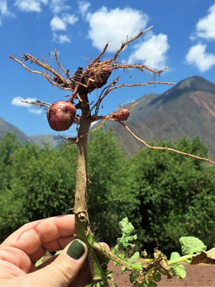We welcome Nina Boys as our guest blogger this week. Nina is an avid explorer and passionate traveler whose journeys have taken her across five continents to some of the world’s most beautiful natural and cultural wonders. Nina has served as a judge for the National Geographic World Legacy Awards, honoring the planet’s sustainable travel visionaries, and has a knack for finding unique travel experiences wherever she goes. She is known to seek out up-and-coming art scenes, local delicacies at street food stands around the world, and opportunities to scuba dive on vibrant coral reefs, all while blogging about her off-the-beaten path adventures for publications including Virtuoso.com, Huffington Post and Roads & Kingdoms.
The night is young, the air warm, and I am on a mission to find what is arguably the most famous restaurant in South America. Strolling Lima’s hip Barranco neighborhood, I wind past vibrant street murals searching for ‘Casa Tupac’ – Virgilio Martínez’s new culinary complex that houses Central, his celebrated brainchild, and its sister establishments. Martínez has become one of the most highly sought-after chefs in the world since debuting Central’s Mater Elevations – an innovative tasting menu which takes diners on a voyage through Peru’s varying altitudes by creatively showcasing the indigenous ingredients native to each place.
Swinging open Casa Tupac’s heavy doors, I notice what looks like a small glass laboratory where botanical specimens hang organized by their scientific names. In my quest for gastronomic greatness, I have discovered the biological and cultural research center behind Martínez’s growing culinary empire. Enter Mater Iniciativa: the driving force behind what just may be the future of Peruvian cuisine.
The innovative project is led by Chef Martínez’s sister Malena, who travels throughout the elevations of Peru with a team of experts to collect, study and ultimately preserve the incredible diversity of plants that thrive within one of the four most megadiverse countries on earth. By digging deeply into Peru’s wild ecosystems, from the dense Amazon jungle to sweeping grasslands to the mighty Andes mountain range, Mater Iniciativa gains new knowledge on the nation’s natural and cultural diversity with help from the indigenous peoples who call the distinct regions home. In turn, the research shines an international spotlight on Peru’s many unique cultures and crops through scientific discovery, interactive conferences, and once at Central, thought-provoking fine dining. My next stop is Cusco, where beneath the beating midday sun of the Sacred Valley of the Incas, I watch patiently as local farmer Manuel digs deep in the fertile earth, pulling out gnarled tubers. He shakes off a film of soil to reveal rich shades of magenta and ochre while whispering to himself in Quechua, the mother tongue of the Inca. Andean culture, he explains, shares an ancient spiritual connection with pachamama, Mother Earth, and her many crops – including the sacred potatoes that have been grown here for millennia. I acknowledge his words with a solemn nod. We are, after all, in the epicenter of potato diversity, where over half of the world’s known varieties are found.
Corn is another important staple, which the Inca fermented into a beer known as chicha de jora, considered a bridge to the gods and used in sacred ceremonies. The sour corn libation is still popular in the Andres today and can be sampled at one of the region’s many chicherías – just be sure to pour some out for pachamama before imbibing.

Once again in Lima, I head to Central’s more casual sister restaurant Kjolle – run by Chef Martínez’s wife, Pia León. Tucking into a savory quinoa tart topped with rainbow-hued ribbons of root vegetables from the Sacred Valley, I reach for a gin-based cocktail shaken with Amazonian cocona fruit and dusted with coca leaf powder. When the server asks how I am enjoying my meal, I pause to reflect on all the scientific and cultural research that has gone into it, and on the limitless possibilities that seem to exist in Peruvian cuisine. With an appetite stronger than my desire to translate such thoughts, I simply smile and reply “Es perfecto. Salud.”
To explore Peru’s amazing cuisine as well as it’s people, culture and history, start planning your own journey to Peru.